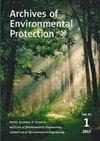Encapsulation of halloysite with sodium alginate and application in the adsorption of copper from rainwater
IF 1.3
4区 环境科学与生态学
Q4 ENVIRONMENTAL SCIENCES
引用次数: 2
Abstract
by-products (Li et al. 2020). Currently, new sorption materials have been found for water purification that are readily available, economical and environmentally friendly. Clay materials are one of the cheap and natural adsorbents (Zhao et al. 2021). The use of natural clay minerals as adsorbents is widely used due to their high efficiency, relatively low operating costs and the possibility of recycling and regeneration (Derafa Garmia et al. 2018). Encapsulation has many advantages. One of them is the immobilization of the fine adsorbent powder. Adsorption with finely powdered material causes problems in recovering fine clay particles from the water, which additionally increases the turbidity of the water. Therefore, encapsulation of halloysite with sodium alginate polymer can be proposed as a solution to avoid these problems. Adsorbents should have good sorption capacity for heavy metals and appropriate porosity ensuring their removal (Pawar et al. 2020). As part of this study, laboratory-scale experiments were carried out to assess the effectiveness of the use of composite capsules based on halloysite and sodium alginate for the adsorption of copper海藻酸钠包埋高岭土及其在雨水中铜吸附中的应用
副产品(Li et al. 2020)。目前,人们已经发现了易于获得、经济环保的新型水净化吸附材料。粘土材料是廉价的天然吸附剂之一(Zhao et al. 2021)。天然粘土矿物作为吸附剂因其效率高、运行成本相对较低、可回收再生而被广泛使用(Derafa Garmia et al. 2018)。封装有很多优点。其中之一是细吸附粉的固定化。细粉状材料的吸附会导致从水中回收细粘土颗粒的问题,这又增加了水的浊度。因此,可以提出用海藻酸钠聚合物包封高岭土作为避免这些问题的解决方案。吸附剂应具有良好的重金属吸附能力和适当的孔隙度,以确保其去除(Pawar etal . 2020)。作为本研究的一部分,进行了实验室规模的实验,以评估使用基于高岭土和海藻酸钠的复合胶囊吸附铜的有效性
本文章由计算机程序翻译,如有差异,请以英文原文为准。
求助全文
约1分钟内获得全文
求助全文
来源期刊

Archives of Environmental Protection
ENVIRONMENTAL SCIENCES-
CiteScore
2.70
自引率
26.70%
发文量
0
期刊介绍:
Archives of Environmental Protection is the oldest Polish scientific journal of international scope that publishes articles on engineering and environmental protection. The quarterly has been published by the Institute of Environmental Engineering, Polish Academy of Sciences since 1975. The journal has served as a forum for the exchange of views and ideas among scientists. It has become part of scientific life in Poland and abroad. The quarterly publishes the results of research and scientific inquiries by best specialists hereby becoming an important pillar of science. The journal facilitates better understanding of environmental risks to humans and ecosystems and it also shows the methods for their analysis as well as trends in the search of effective solutions to minimize these risks.
 求助内容:
求助内容: 应助结果提醒方式:
应助结果提醒方式:


